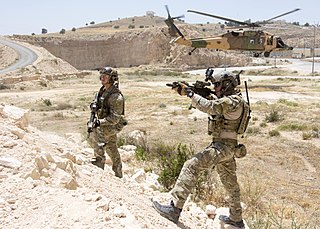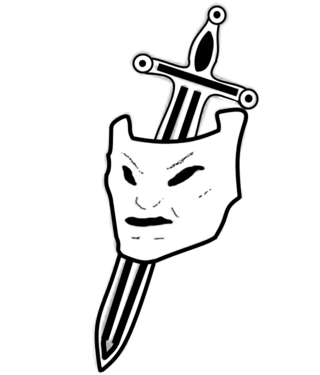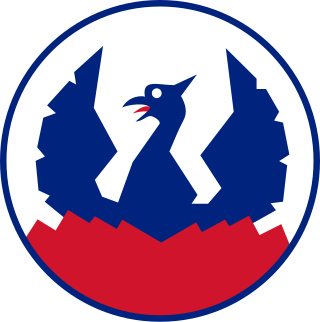
A commando is a combatant, or operative of an elite light infantry or special operations force, specially trained for carrying out raids and operating in small teams behind enemy lines.

Special operations or special ops are military activities conducted, according to NATO, by "specially designated, organized, selected, trained, and equipped forces using unconventional techniques and modes of employment." Special operations may include reconnaissance, unconventional warfare, and counterterrorism, and are typically conducted by small groups of highly trained personnel, emphasizing sufficiency, stealth, speed, and tactical coordination, commonly known as special forces.

The Brandenburgers were members of Nazi Germany's Wehrmacht special forces unit during World War II.

Force 136 was a far eastern branch of the British World War II intelligence organisation, the Special Operations Executive (SOE). Originally set up in 1941 as the India Mission with the cover name of GSI(k), it absorbed what was left of SOE's Oriental Mission in April 1942. The man in overall charge for the duration of its existence was Colin Mackenzie.
The name commando has been applied to a variety of Australian special forces and light infantry units that have been formed since 1941–42. The first Australian "commando" units were formed during the Second World War, where they mainly performed reconnaissance and long-range patrol roles during Australia's campaigns in New Guinea and Borneo, although other units such as M and Z Special Units performed more clandestine roles. These units were disbanded following the end of the war; however, in the 1950s it was realised that there was a need for such units again in the Australian forces. Today, the Australian Army possesses a number of units that perform more conventional direct-action type commando roles, as well as counter-terrorism response, long-range patrolling, and clandestine deep-penetration operations.

Beach Jumpers were U.S. Navy special warfare units organized during World War II by Lieutenant Douglas Fairbanks Jr. They specialized in deception and psychological warfare. The units were active from 1943 to 1946 and 1951 to 1972.
The Allied Intelligence Bureau (AIB) was a joint United States, Australian, Dutch and British intelligence and special operations agency during World War II. It was responsible for operating parties of spies and commandos behind Japanese lines in order to collect intelligence and conduct guerrilla warfare against Japanese forces in the South West Pacific. The AIB was formed in June 1942 to coordinate the existing Allied propaganda and guerrilla organisations. The first controller of the AIB was Colonel C. G. Roberts. At its peak the AIB contained men from ten individual services and controlled or coordinated eight separate organisations. The role of the AIB was to obtain information about the enemy, "to weaken the enemy by sabotage and destruction of morale and to lend aid and assistance to local effort to the same end in enemy territories." One member of the AIB was Alfred Deakin Brookes, who went on to become the first head of the Australian Secret Intelligence Service in May 1952.
209th Detachment, 2325th Group, commonly known as Unit 684 (684부대), was the only tier one special forces unit of the Republic of Korea Air Force (ROKAF) that specialized in black operation, direct action, irregular warfare, long-range penetration, and special operations that are extremely high-risk and dangerous. It was formed to assassinate North Korean leader Kim Il Sung in 1968, in retaliation for the North's botched Blue House raid.
The United Nations Partisan Infantry Korea was a guerrilla commando unit during the Korean War that was consolidated under the control of United States Far East Command.

Special reconnaissance (SR) is conducted by small units, such as a recon team, made up of highly trained military personnel, usually from special forces units and/or military intelligence organizations. Special reconnaissance teams operate behind enemy lines, avoiding direct combat and detection by the enemy. As a role, SR is distinct from commando operations, but both are often carried out by the same units. The SR role frequently includes covert direction of airstrikes and indirect fire, in areas deep behind enemy lines, placement of remotely monitored sensors, and preparations for other special forces. Like other special forces, SR units may also carry out direct action and unconventional warfare, including guerrilla operations.
National governments deal in both intelligence and military special operations functions that either should be completely secret, or simply cannot be linked to the sponsor. It is a continuing and unsolved question for governments whether clandestine intelligence collection and covert action should be under the same agency. The arguments for doing so include having centralized functions for monitoring covert action and clandestine HUMINT and making sure they do not conflict, as well as avoiding duplication in common services such as cover identity support, counterespionage, and secret communications. The arguments against doing so suggest that the management of the two activities takes a quite different mindset and skills, in part because clandestine collection almost always is on a slower timeline than covert action.
In US military doctrine, unconventional warfare is one of the core activities of irregular warfare. Unconventional warfare is essentially support provided by the military to a foreign insurgency or resistance. The legal definition of UW is:
Unconventional Warfare consists of activities conducted to enable a resistance movement or insurgency to coerce, disrupt or overthrow an occupying power or government by operating through or with an underground, auxiliary or guerrilla force in a denied area.

The Air Resupply And Communications Service (ARCS) is an inactive United States Air Force organization. It was assigned to Andrews Air Force Base, Maryland. Established during the Korean War, the mission of ARCS was providing the Air Force an unconventional warfare capability during the 1950s. It was inactivated in 1954, but elements continued to operate until the reactivation of air commando units by the Kennedy Administration in 1962.

Guerrilla warfare was waged during the American Civil War (1861–1865) by both sides of the conflict, but most notoriously by the Confederacy. It gathered in intensity as the war dragged.

Special forces or special operations forces (SOF) are military units trained to conduct special operations. NATO has defined special operations as "military activities conducted by specially designated, organized, selected, trained and equipped forces using unconventional techniques and modes of employment".

The U.S. Army Special Forces traces its roots as the Army's premier proponent of unconventional warfare from purpose-formed special operations units like the Alamo Scouts, Philippine guerrillas, First Special Service Force, and the Operational Groups (OGs) of the Office of Strategic Services. Although the OSS was not an Army organization, many Army personnel were assigned to the OSS and later used their experiences to influence the forming of Special Forces.
The 6004th Air Intelligence Service Squadron was "the first covert collection agency in the history of the United States Air Force". Begun by Major Donald Nichols as an impromptu extension of his pre-Korean War espionage in 1950, it was first dubbed "Special Activities Unit Number One". In April or May 1951, it officially became the 6004th Air Intelligence Service Squadron. The 6004th was an unorthodox unit that engaged in espionage and aircrew escape and evasion, as well as collecting information. It was Far East Air Force's primary supplier of intelligence for the war, generating as many as 900 reports per month.
The Donkeys were a partisan force during the Korean War that consisted of anti-communist North Korean defectors who engaged in guerrilla warfare, long-range penetration, and search and rescue POWs. The fighters were formed under the United Nations Partisan Infantry Forces. Guerrillas had a huge impact on the United States effort in North Korea. In the end, these partisan forces conducted 4,445 actions in North Korea that led to the capture of 950 prisoners, 5,000 weapons, 2,700 destroyed vehicles, 80 bridges demolished, 69,000 casualties, 3,189 guerrilla deaths, and only four American advisers were KIA. Furthermore, according to the 5th Air Force, of the 93 pilots who had been shot down and evaded capture between July 1950 and January 1952, guerrilla fighters rescued 29.
The Korea Liaison Office (KLO) was an American military intelligence unit composed primarily of South Koreans. It operated between June 1, 1949 and July 1951.












